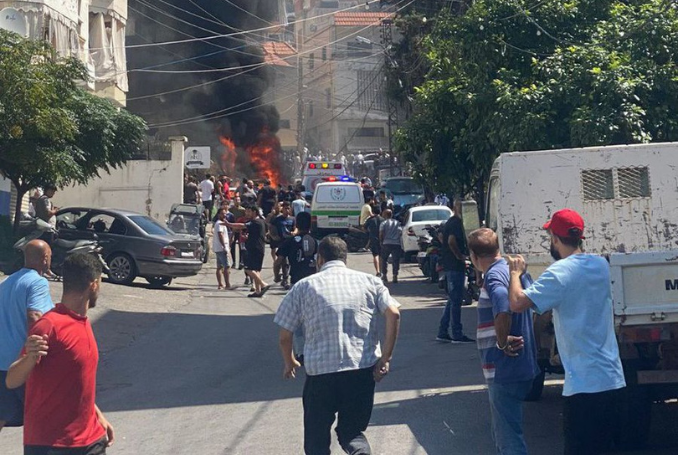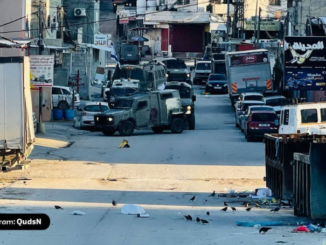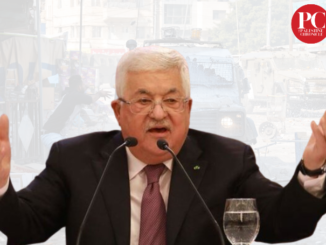
By Jeremy Salt
If the West/Israel cannot win the war, if they are unable to finish what they have started, their hegemonic hold will be broken.
The war likely to decide the future of the Middle East for the next century has already started. Gaza was the trigger. The evidence suggests that Netanyahu knew the Hamas attack was coming on October 7 and did nothing to stop it.
He was certainly warned several times well beforehand, by Egypt, by soldiers close to the Gaza fence who spotted Hamas training and by the 8200 electronic intelligence unit. The ‘failure’ to act on all these warnings is not persuasive.
The surveillance of Gaza is the most intense in the world and the only realistic conclusion can be that Netanyahu wanted a pretext not just to obliterate Gaza but to start a regional war allowing Israel – in conjunction with the US – to destroy all its enemies at once. Accordingly, he allowed the Hamas attack to go ahead, even knowing that Israelis would be killed. For a man as cynical and corrupt as Netanyahu, it is not at all too cynical to suggest that this was his train of thought and in no way does this diminish the significance of the Hamas attack.
Step by step Netanyahu has deliberately taken the Middle East to the edge of the precipice and is now pushing it over. He has never been interested in peace with the Palestinians. What he wants is surrender, at the point of a gun. He opposed the Camp David ‘peace process’ from the beginning and in the past year has repeatedly torpedoed ceasefire negotiations. There is no Palestine on his map, only a Jewish state between the river and the sea.
The pager/walkie-talk mass terror attack on Lebanon killed at least 37 people and wounded hundreds. Many of the victims were partially or totally blinded when the pagers and walkie-talkies blew up in their faces.
In many cases, the eyeballs were blown out of their sockets. The casing of the devices had been packed with small metal balls to maximize the bodily damage. Enough time was allowed between the beeping and the explosion for the victim to pick up the pager or walkie and hold it to his or her face.
This is what Rupert Murdoch’s ‘Australian’ newspaper described derisively in a front-page headline as the ‘maim event.’ The UN human rights commissioner, Volker Turk, called the attack a war crime.
The pagers were widely distributed among the civilian population despite the claim by Israel that the targets were Hezbollah ‘terrorists.’ Doctors, other medical staff and security guards were likely to be carrying the pagers, which exploded in the streets, in cars, in supermarkets, and in family homes across Lebanon.
The two days of electronic terrorism were followed by the bombing of a Beirut residential district and the killing of more civilians – including women and children – along with the senior Hezbollah figures being targeted. Thirty-one bodies were recovered but after a day, 23 more were still missing under the rubble.
On the West Bank, the killing of Palestinians continued, the contempt and hatred of soldiers and settlers summed up in the video of three dead or wounded young men being shoved off the roof of an apartment building with the push of a soldier’s boot. Even in death, the Zionists show no respect for the Palestinian dead. Having killed the journalist Shereen Abu Akleh with a sniper’s bullet to the head, soldiers converged on her funeral procession to laugh and jeer.
Intense Israeli attacks on southern Lebanon continue, with Hezbollah responding with missile attacks on military targets close to Haifa it had already identified in its drone surveillance.
The air campaign is most likely the prelude to a land invasion aimed at creating a ‘buffer zone’ on the Lebanese side of the 1949 armistice line. How large this ‘buffer zone’ might be remains to be seen but what the past tells us is that Israel’s wars always have hidden as well as stated objectives.
Hezbollah
The Litani River, 30 kilometers from the armistice line, has been on Israel’s expansionist map ever since the post-1918 carve-up of the Middle East by the victorious powers. The 1917 Balfour Declaration signaled Britain’s intention to eventually hand Palestine over to the Zionists.
With this in mind, the Zionist delegation at the 1919 Paris ‘peace’ talks wanted the borders of the “Zionist state” to begin just south of Sidon in the north. They would include all of what is now southern Lebanon apart from a coastal strip between Sidon and Tyre (Sur). The southwest border would include part of Sinai and the southeast both banks of the Jordan River.
This was unacceptable both to Britain and France. Britain created Transjordan on the east bank of the Jordan River, while France took possession of all of what is now Syria and Lebanon.
In September 1920, carving the state of ‘Greater Lebanon’ out of Syria, France created a Maronite Christian-dominated enclave it believed would be loyal to French/western interests and hostile to the rising tide of Arab nationalism. Even if its demographic understanding was true then, it has long since ceased to be true. A census has not been held since 1932 but in the current Lebanese plurality, there is no doubt that the Shia are the most numerous.
In the years before the 1967 war, Israel bombed Syria to prevent the diversion of water flowing into the Sea of Galilee from the Golan Heights. Israel partially withdrew from the Golan in 1974 but remains in illegal occupation of 70 percent of the territory, which it equally illegally annexed in 1981.
The Golan is now dotted with settlements, military outposts and lakes, dams and reservoirs not only feeding the settlements but providing pre-1967 Israel with about 15 percent of its water needs.
Having been driven out of southern Lebanon by Hezbollah in 2006, Israel will return to the south with the intention of staying. Like David Ben-Gurion in 1948 and the politicians in 1967, war in Lebanon will provide cover for further possible expansion of the Jewish state.
In a history of extreme governments and politicians, the Netanyahu government is the most extreme.
Netanyahu is himself a territorial maximalist but without the support of equally extreme political factions, his government would not survive. Just as the Labor government of the 1960s allowed the settler groups to make the running in the occupied West Bank, as if they were beyond its control, so Netanyahu prefers the current ‘extremists’ to act as his stalking horses and say out loud what he prefers not to say. In this fashion, the ground is being laid for the occupation of southern Lebanon.
In November 2023, Amichai Friedman, rabbi at the Nahal Brigade training base, delivered a fiery address to soldiers. “This land is ours!” he insisted. “The whole country! All of it! Including Gaza! Including Lebanon! The whole promised land!” The West Bank settler leader Daniella Weiss describes the borders of the Jewish state as “the Euphrates in the east and the Nile in the southwest.”
In June 2024 the Movement for Settlement in southern Lebanon sent balloons and drones over the armistice line carrying messages demanding that the civilian population leave immediately: “Warning! This is the land of Israel, belonging to the Jews. You are required to evacuate immediately.”
A virtual conference held by the movement attracted about 800 participants, joining in the discussion of such topics as “Lebanon in the Bible” and “Successful settlement models from the past and lessons for south Lebanon.”
Bezalel Smotrich, the minister for finance, who said in August 2024 that “it might be just and moral” to starve the more than two million Palestinians of Gaza until the hostages are returned “but the world won’t let us,” has called for an armed attack “deep into Lebanese territory to defend the northern communities,” followed by a military takeover of the entire southern region.
It is worth bearing in mind here that if Israel has never declared its borders, it is for a good reason, which is further territorial expansion once opportunity knocks or can be created. What also needs to be remembered is the way a handful of ‘extremists’ led by Rabbi Moshe Levinger were allowed by the government to begin the incremental settlement of the West Bank in 1968.
No one then could imagine the level it would reach and there is no reason why settlement in southern Lebanon down as far as the Litani River would not develop in the same way under Israeli occupation. Having failed to stop illegal settlement in East Jerusalem and the West Bank, neither is there any reason to think the ‘west’ would be any more interested in stopping it in southern Lebanon.
Back to the Stone Age
Israeli politicians and generals have threatened many times that in the next war, they would return Lebanon to the Stone Age. Beirut and the country’s civilian infrastructure would be pulverized while in the south the civilian population in the proposed ‘buffer zone’ would be terrorized into flight. As this has happened before, in 1982 when villagers in the south fled before the advance of the Israeli army, there is no reason to think it would not happen again.
In 2006 Hezbollah’s reserve soldiers prevented Israel’s ground troops from advancing more than a few kilometres from the armistice line. If they did not reach the Litani River it was because they could not. Humiliated by this part-time army, Israel took out its anger and frustration through intensive missile strikes on the Dahiyya suburb of Beirut.
A residential and commercial district, with a mixed Christian and Muslim (largely Shi’a) population, including about 30,000 Palestinians, Dahiyya is also the center of Hezbollah’s political and administrative presence in Beirut. This includes its parliamentary role and its social welfare, health, education, and housing services along with planning by its military committees. The destruction of Dahiyya in 2006 is being threatened again only on a wider and broader scale.
The missile attack that killed Ibrahim Aqil plus civilians, including women and children and other senior commanders in the Radwan unit, was a spectacular success for Israel but in admitting the grievous blow Hezbollah had suffered, Nasrallah remarked that setbacks are as intrinsic to warfare as victories. Despite western media’s jubilation at Israeli cleverness, Hezbollah’s military capacity remains intact.
Hezbollah immediately responded to the killings in Beirut and the waves of Israeli missile strikes that followed in the south, with retaliation against Israeli military targets, including the Ramat David air base close to Tel Aviv and the Rafael ‘defence’ systems production complex near Haifa. These were the deepest Hezbollah strikes inside occupied Palestine since October 7.
The Middle East is now involved in the first stages of an existential war which is likely to have the same transformative effect on the region as Sykes-Picot did after 1918. Sykes-Picot ushered in a period of western/Israeli regional military and political domination which only now is being threatened. The ‘new American century,’ the ‘greater Middle East’ and the wars on Iraq, Libya and Syria were attempts to shore up the western position but decline has continued in the context of general global western decline.
The ‘west’ created Israel and had 80 years to force it to live within the parameters of international law but instead chose to arm and finance it despite decades of illegal occupation and the atrocities it was committing year after year. The point had to come when the possibility of the west playing a constructive role in settling the ‘Palestine question’ had to be written off. Its acquiescence even in genocide drove the point home like a dagger plunged by the west into its own heart.
The message has finally sunk in that Israel will not stop until it is stopped. The ‘west’ has shown itself incapable of doing it but if the Middle East is ever to have a life of its own someone must. That responsibility now rests on the shoulders of the ‘axis of resistance.’
If the west/Israel cannot ‘win’ this war – winning defined as inflicting more catastrophic damage on its enemies than the catastrophic damage they have inflicted on theirs – if unexpectedly, because they have no doubt they will win, as they always have done, they are unable to finish what they have started, their hegemonic hold will be broken. If alternatively the west ‘wins’ again, the past will not be another country but quite a familiar one.

– Jeremy Salt taught at the University of Melbourne, at Bosporus University in Istanbul and Bilkent University in Ankara for many years, specializing in the modern history of the Middle East. Among his recent publications is his 2008 book, The Unmaking of the Middle East. A History of Western Disorder in Arab Lands (University of California Press) and The Last Ottoman Wars. The Human Cost 1877-1923 (University of Utah Press, 2019). He contributed this article to The Palestine Chronicle.








My uncle Sam is a serial killer. We the People keep trying to stop him but he’s out of control. A lethal combination of murder, pedophilia, drug trafficking, trafficking in weaponry, enabling terrorism all over the world has made him a senseless berzerker smiting the heads of children for democracy. If he was a dog, his owner would take him out back and put him out of his misery. For Humanity.